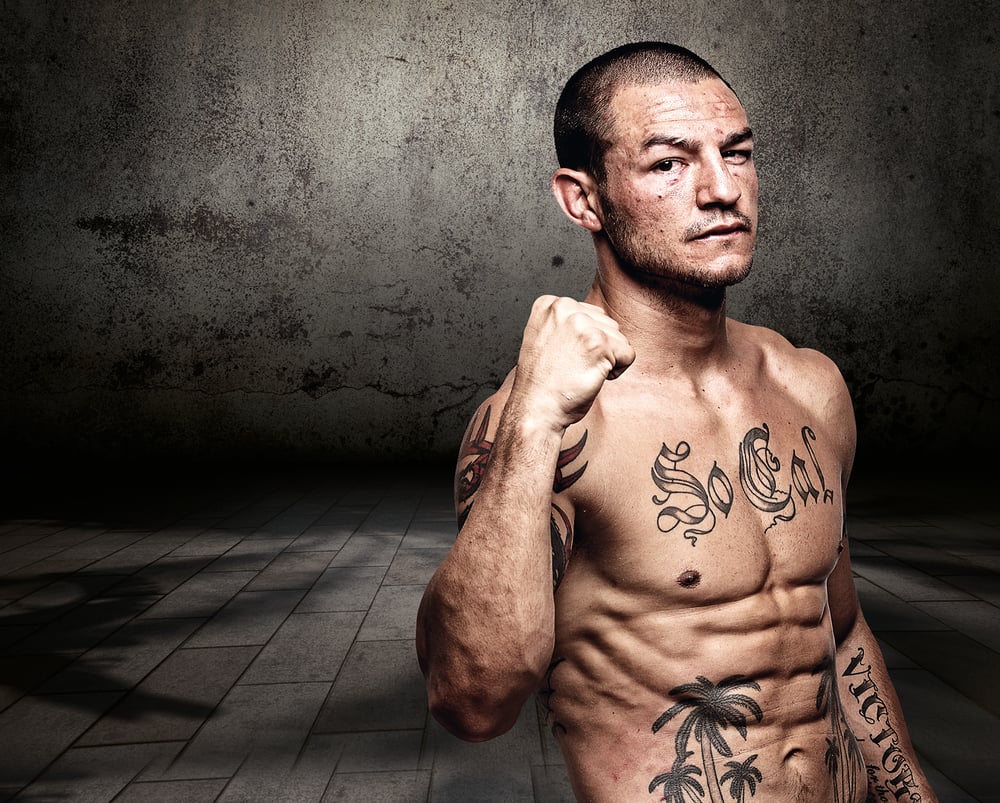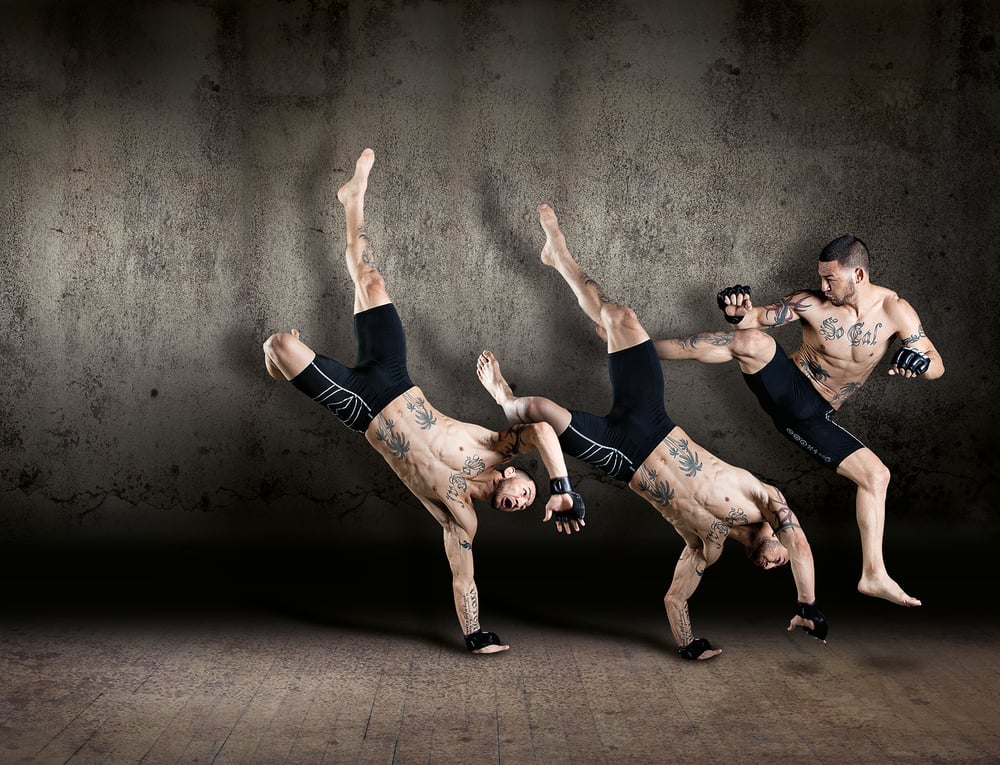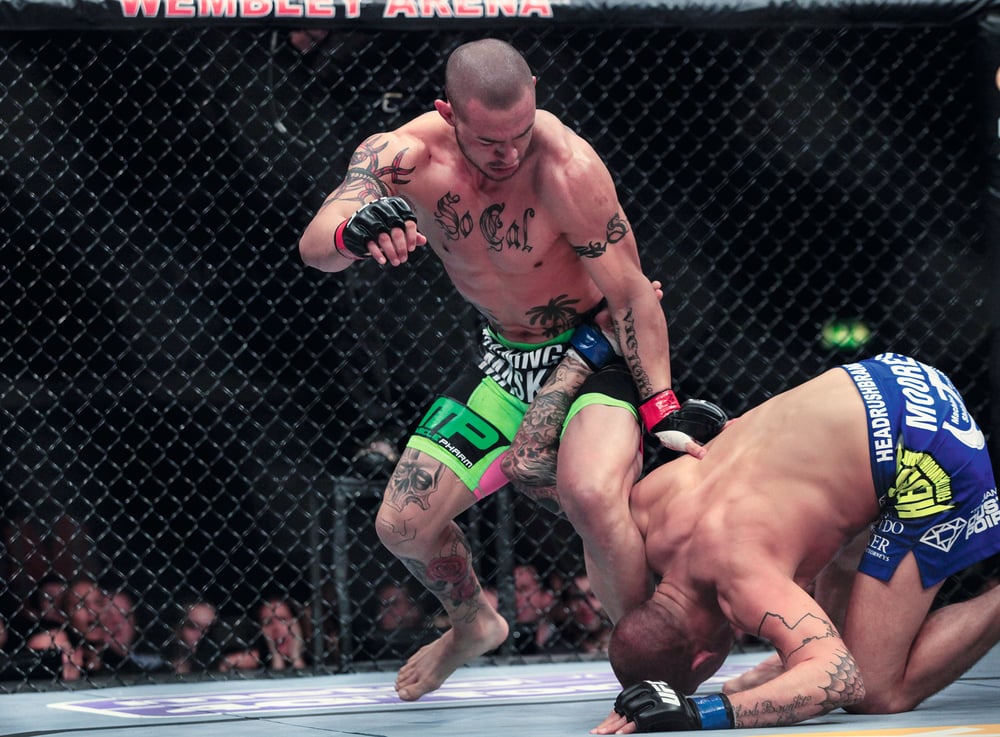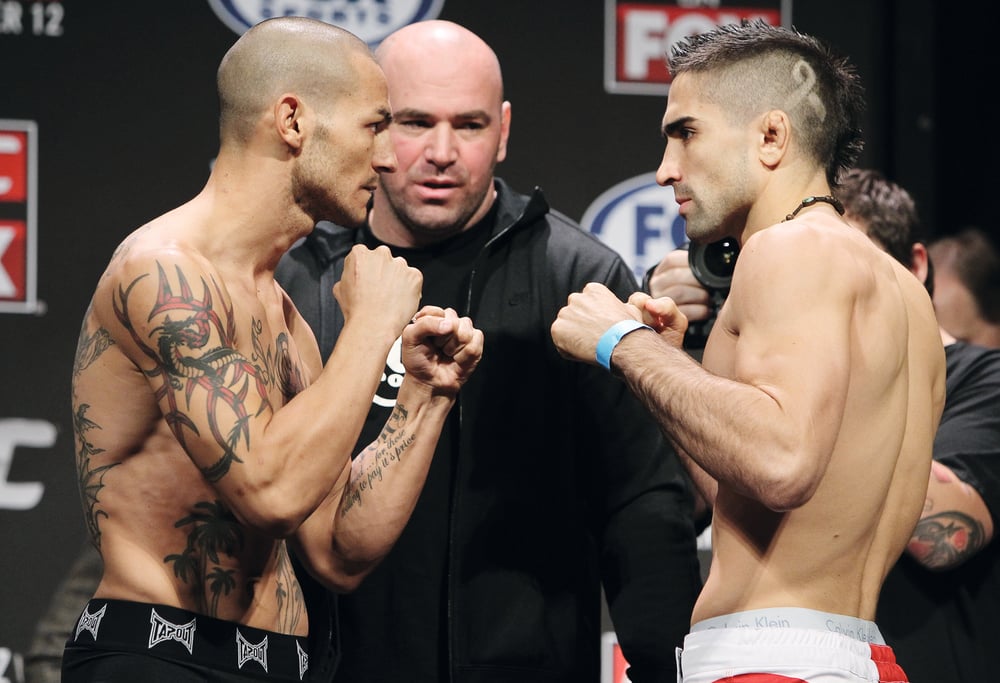
Issue 102
June 2013
From growing up in juvie and writing essays in toilet blocks, to fighting in a pit inside a Tijuana nightclub, former wild child Cub Swanson is living proof that inspiration and perspiration can lead to salvation – and, perhaps, a UFC title.
Detained as a teenager for waging war on the wrong side of the tracks, and even starting out his early fight career in a man-made cave in Tijuana surrounded by beer-swilling lunatics, Cub Swanson’s life has all the hallmarks of a crazy road movie. But he insists his path will lead to the UFC title.
We have witnessed the evolution and maturity of Swanson the fighter and athlete as his MMA career winds into its world-class phase in his early 30s. Four wins in his last four fights – three by knockout – last time out he looked both cool and calculated, yet still vicious, as he pushed past Dustin Poirier in the race for featherweight contention.
Yet the man and his mindset are so different today to the teenager who, in his wild years, showed his middle digit to authority, followed by his early days as a fighter who had a laissez-faire attitude about who, where and when he might find himself, hands up, opposite an opponent for a fistful of dollars.
As a youngster he set out, in his words, “to party hard with my brothers.” For his sins, he ended up in juvenile hall. “You make a dumb decision and you can end up in a bad spot,” he explains to Fighters Only.
Swanson was a wild child. But being under lock and key sobered him up. He soon realized he was wasting his time. Deep down, he was resourceful, naturally intelligent, and it began to show. “The schoolwork was so easy it was just a matter of how much time you could put into it. I was so driven and focused because I realised I was wasting time in there.”
In a clever, yet illicit, way he did extra homework. “I would break out the lead from my pencil. I didn’t want to get into any trouble because it was a huge offense taking a pencil into the dormitory. They were afraid people would stab each other or vandalize things, so I would take the tip off my pencil. I hoped my teacher wouldn’t catch me, and see that I had broken it off.
“I would re-sharpen the pencil before it was collected up, then I would hide the lead in my shoe. We were strip-searched every time we got back to our dorms, which had cameras. Later, I’d sit on the toilet where they weren’t allowed cameras, and I would take toilet paper, turn it into a small rope, and use the elastic from my underwear to make a pencil and I would do my homework. I spent hours there on the toilet, writing essays.”

It paid off. He passed exams with flying colors. “As a result, I got transferred from a juvenile hall to a group home – like a boys’ boarding house – and while everybody there at juvenile hall had to go to a continuation school for bad kids, I was able to go to a regular high school, which was right across the street.” At the new facility, staff still monitored the boys 24 hours a day.
Enrolled back into regular classes at Arlington High School, Riverside, Swanson excelled. “It was a really good high school. I began to play soccer for the school team, which meant privileges. Like I was able to come home later than everyone else.” He saw a path to redemption.
“So when the soccer season ended, I tried out for the tennis team, and made the varsity tennis team, though I’d never played before. I was actually the number two spot on the team. I only did that because I got to stay out later. Otherwise, you had to report back to the facility, and you weren’t allowed to leave the house for the rest of the day.
“I was on probation, still in the custody of the juvenile system. It was like a boys' home, so I got to see my family once a week. My mum would drive out there regularly. I was there for nine months.”
He was 17 when he finally got out, after graduation, in July 2001. He recalls: “They wouldn’t release me until I had graduated. I was actually up for early release a couple of months earlier, but the judge said I was doing so good that he would hate to see me mess it up, so he left me in there longer. I was hoping I’d be good enough to redeem myself.”
He continued playing soccer and says that although there were talented boys in the teams he played in, “no one ever got out of there, in Palm Springs.” In the same year group at high school was Timothy Bradley, the world champion welterweight boxer. And Cub reveals he and Bradley recently visited a high school back home together to talk to the kids there.

Freed from the constraints of the juvenile justice system, young Swanson did good work, but he was still looking for an athletic avenue for his highly competitive spirit. He went to college, for one year, on a soccer scholarship. But he dropped out. He realized team sports were not for him.
“We were not living up to our expectations on my junior college team. So that kinda burnt me out on team sports ‘cause I was always putting it all out there and the rest of the team weren’t,” he recalls. “As I got older it just seemed like team sports weren’t for me anymore.
“Then I started doing some martial arts, trying to get into some form of competition and I walked into a jiu-jitsu school and got my ass kicked by some nerdy kid. I was like, ‘How’s this kid kicking my ass?’ So I decided to give it a shot. And the rest is history, pretty much. Yeah, I started doing jiu-jitsu tournaments, started doing real well.”
Around the same time, he also began working with disabled kids, and it had a profound impact on him, influenced, no doubt, by his sister Leiana, who has Down’s syndrome. “I got into it because of my youngest sister. Leiana was signed up to these programs. A company called United Cerebral Palsy was hiring staff. I had been living on my own, I was like 17, so my mum got me a job over there and I worked there for four years.”
Swanson excelled. He was paid as a driver, but he got involved completely. “I’d go pick up kids from school, work the lift and put the kids in the wheelchairs and take them back to our program. We had an after-school program and we worked with kids on their social skills. We had a lot of kids with autism. They’re very anti-social. So we were trying to engage the kids, get them involved and playing games together.
“But I would do it all, man, even changing diapers. I got beat up. I got bitten, scratched, punched, beat on, everything. It was a tough job but it was also very rewarding.”
But the fighting side of his life was also warming up, and people around him were urging him to compete for money. In 2004, he headed down to Tijuana to take part in his first MMA fight. Over the border he went, with War Machine, Kendall Grove and ‘Rude Boy’ Troy Mandaloniz, to fight in a man-made nightclub built like a cave, in the Mexican border town.
Swanson recalls: “Being a little bit dumb helps when you are younger. It means you are willing to take risks. But it was awesome, too. The arena was in the Baby Rock nightclub. It was like three levels all enclosed, people cheering and it really was a wild feeling.
“It was a hell of a way to start my MMA career, being in Tijuana, Mexico, you know. People go down there to have a crazy time.” He was to fight there three times – in his first three ‘pro’ fights.
“The weigh-ins were in San Diego, on the Friday, and we would fight on the Saturday. We would drive down there, take a taxi to the venue, hang out backstage and just wait to fight,” he says. “My first fight was against Shannon Gugerty, who also later fought in the UFC. We ended up fighting twice, but he beat me in my first fight in about 30 seconds. Going all the way down there and getting humbled, that was pretty embarrassing, but I went on to win 11 straight after that.
“There was one time I had to jump on my cornerman’s back and walk through the hallway on the way to the ring because there was so much broken glass on the floor. It was such a weird thing because the hallways leading out into the ring were so skinny.
“On the way back we’d pull over and stop on the Mexican side by the border because, at the time, our dollar was pretty strong, and you could get everyone tacos and drinks, even with the little bit of money I got paid. I think I got 200 bucks a fight.”

A lot of water has passed under the bridge from that raw recruit to the honed athlete, physically and mentally, that we are now witnessing walk to the Octagon. Swanson, ranked number five in the UFC’s 145lb division, has serious designs on the title. The angry young man has long gone.
So what does he put the greater maturity down to? “I’d say the biggest thing to change is that, in the past, I wanted to show I was the toughest guy out there, and I don’t really feel like that’s necessary anymore. I’ve proven that I’m tough. I’ve also realized that I’m a very intelligent fighter.”
And the title shot? “It’s going to come; I know it’s my time. I’m stepping into my prime and whether I get it this year, next year, or the year after, it’s going to happen. That’s my goal.”
Avenging defeats to Ricardo Lamas and incumbent champion José Aldo are there, lodged in his mind, but not as an obsession. The Aldo defeat, coming eight seconds into their WEC 41 clash back in November 2009, he reckons, was down to his own impetuousness.
He adds: “One thing I’ve learned, taking a page out of Clay Guida’s book, is to enjoy every moment in the UFC. I don’t turn into a mean animal until the day I fight. The guy I used to be was miserable for a whole week in a killer mood. Now I have a good time and when it’s time to fight, I’m ready. I don’t have a problem turning that switch on. And I don’t need a whole week to do it.
“I just want to continue trying to get better. I still see things in my game that I want to improve, little things. I’m talking about inches, you know. It’s a game of inches.” That game of inches won him his last contest, with Poirier on February’s UFC on Fuel TV card in London.
Having ‘found’ himself, and grown, Swanson will not forget his journey, his roots – for better or for worse. “Because I got in trouble, and spent time in juvenile hall, I go back to that place, Indio Juvenile Hall, in California, and talk to the kids there sometimes. They watch my fights.
“Most of the kids in there are good kids. They just had a rough childhood and ended up acting out of turn, making dumb decisions. Like I did. It’s just about decisions. You make a bad decision, bad things happen. Make good decisions, you end up co-main event in the UFC in another country.” Inspiration and perspiration: the winning story of Cub Swanson.
Timeline
1983: Born Kevin Luke Swanson in Palm Springs, California. Given the nickname ‘Cub’ by his older brother, Steve.
2000: Spends two years in Indio juvenile hall after being charged with breaking and entering.
2002: After being released from juvie in 2001, begins working with children with cerebral palsy. Starts training at Joe Moreira’s Jiu-Jitsu in California.
July 2004: Loses his debut fight, at Total Combat 4, against soon-to-be UFC lightweight competitor Shannon Gugerty via rear naked choke in just 15 seconds.
October 2004: Returns quickly at Total Combat 6 and defeats Joe Morales via submission due to punches.
2005: Fights exclusively for California-based promotion, King of The Cage, going 3-0 under its banner.
2006: One of the busiest periods in his career, Swanson goes 4-0, makes his drop to featherweight and finally earns his way into the WEC by knocking out Chuck Kim at Beatdown in Bakersfield.
March 2007: Makes his WEC debut at WEC 26 defeating fellow debutant Tommy Lee via guillotine choke in the first round.
December 2007: After going 2-0 in the WEC, suffers the second defeat of his career to former UFC lightweight champion, Jens Pulver, losing via guillotine choke in just 35 seconds.

2008: Returns to the WEC just under a year later in a ‘Fight of the Night’ performance against Hiroyuki Takaya. The win earns Cub a number-one contender eliminator fight at WEC 41.
June 2009: Suffers a devastating defeat to future WEC and UFC featherweight champion. José Aldo, in eight seconds via double flying knee.
2010: Has a hard beginning to the year, losing via decision to Team Alpha Male standout Chad Mendes at WEC 50, but then wins a split decision ‘FON’ brawl against Mackens Semerzier at WEC 52.
November 2011: After 366 days on the sidelines, makes his UFC debut against Ricardo Lamas on UFC on Fox 1. After dominating Lamas in the opening round, however, he’s submitted via arm triangle choke in round two.
2012: Bounces back from the Lamas defeat by recording three knockouts in a row in 2012 against George Roop, Ross Pearson and Charles Oliveira respectively.
February 2013: Defeats Dustin Poirier in a brilliant back-and-forth battle at UFC on Fuel: Barao vs McDonald.
July 2013: Scheduled to face Dennis Siver at UFC 162 in Vegas, when Cub can edge closer to a 145lb title shot.
...










